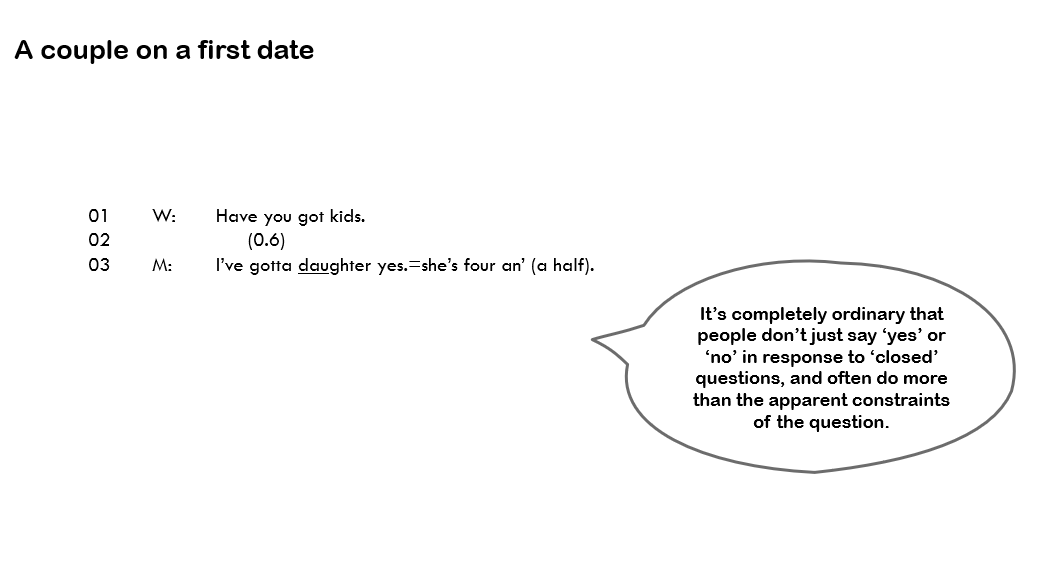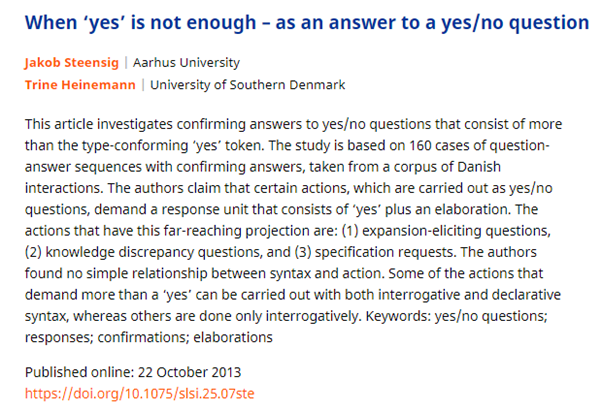“How do open-ended questions improve interpersonal communication?”
TL;DR: They do not.
Let’s explore a common #communication assumption about & #39;open& #39; and & #39;closed& #39; questions with some data to see what they look like, and what they do, in real interaction.
1. Thread. https://abs.twimg.com/emoji/v2/... draggable="false" alt="🧵" title="Thread" aria-label="Emoji: Thread">
https://abs.twimg.com/emoji/v2/... draggable="false" alt="🧵" title="Thread" aria-label="Emoji: Thread">
TL;DR: They do not.
Let’s explore a common #communication assumption about & #39;open& #39; and & #39;closed& #39; questions with some data to see what they look like, and what they do, in real interaction.
1. Thread.
2. Google "open and closed questions” and you’ll find loads of articles and (often written or hypothetical) examples about them - tweet 1 is just one of many.
As @d_galasinski pondered recently: “I wonder who is responsible for fetishising open questions.”
As @d_galasinski pondered recently: “I wonder who is responsible for fetishising open questions.”
3. When we examine questions as they are actually used - ‘in the wild’ - we find that yes/no (‘closed’) questions routinely receive more than ‘yes/no’ in response.
And just because a question is ‘open’ doesn’t mean it& #39;ll be answered.
Let’s see some examples.
And just because a question is ‘open’ doesn’t mean it& #39;ll be answered.
Let’s see some examples.
4. Here& #39;s another example from a group of friends chatting.
[ #EMCA researchers use the & #39;Jefferson& #39; system for transcription - to find out more, see @alexahepburn @BoldenGalina& #39;s book & #39;Transcribing for Social Research& #39;.]
[ #EMCA researchers use the & #39;Jefferson& #39; system for transcription - to find out more, see @alexahepburn @BoldenGalina& #39;s book & #39;Transcribing for Social Research& #39;.]
5. Just saying & #39;yes& #39; or & #39;no& #39; - even when the question requires & #39;yes& #39; or & #39;no& #39; - can even seem a bit rude ...
6. Here& #39;s an example from a first date. The couple has been talking about what they like in a partner.
If someone answers an & #39;open& #39; (& #39;wh-& #39;) question with a a closed response (line 11), perhaps the date isn& #39;t going well... https://abs.twimg.com/emoji/v2/... draggable="false" alt="😬" title="Grimasse schneidendes Gesicht" aria-label="Emoji: Grimasse schneidendes Gesicht">
https://abs.twimg.com/emoji/v2/... draggable="false" alt="😬" title="Grimasse schneidendes Gesicht" aria-label="Emoji: Grimasse schneidendes Gesicht">
If someone answers an & #39;open& #39; (& #39;wh-& #39;) question with a a closed response (line 11), perhaps the date isn& #39;t going well...
7. Why do people so regularly give more than a & #39;closed& #39; response to an apparently & #39;closed& #39; question?
When we look at real talk, rather than imagine talk, it seems pretty ordinary to do so (as in this example from research with @S_Parslow @MFlinkfeldt)
When we look at real talk, rather than imagine talk, it seems pretty ordinary to do so (as in this example from research with @S_Parslow @MFlinkfeldt)
8. In response to a & #39;closed& #39; question from the patient, the #GP receptionist doesn’t just say ‘no’.
Her response conveys ‘no’ while ALSO providing an account for not saying ‘yes’ (as in this example from research with @rein_ove @symondsjon) - because the question is a request.
Her response conveys ‘no’ while ALSO providing an account for not saying ‘yes’ (as in this example from research with @rein_ove @symondsjon) - because the question is a request.
9. Here& #39;s an example of rapidly repeated responses to a & #39;closed& #39; question - again, doing more than required and doing it early (it& #39;s from a study of antenatal consultations conducted with @MagnusHamann @DoctorDot2 @jayne_wagstaff)
11. In this example, the cafe staff apparently doesn& #39;t understand that people make requests by asking a yes/no closed question  https://abs.twimg.com/emoji/v2/... draggable="false" alt="🤔" title="Denkendes Gesicht" aria-label="Emoji: Denkendes Gesicht">
https://abs.twimg.com/emoji/v2/... draggable="false" alt="🤔" title="Denkendes Gesicht" aria-label="Emoji: Denkendes Gesicht">
12. Of course, there are always survey questions, where responses can be constrained by the design of the form, like in these examples from my friends @typeform
13. Politicians often resist answering & #39;closed& #39; questions, like this famous example from 1997 in which Jeremy Paxman asks Michael Howard the same yes/no question - "Did you threaten to overrule him?” - 14 times  https://abs.twimg.com/emoji/v2/... draggable="false" alt="🤔" title="Denkendes Gesicht" aria-label="Emoji: Denkendes Gesicht">
https://abs.twimg.com/emoji/v2/... draggable="false" alt="🤔" title="Denkendes Gesicht" aria-label="Emoji: Denkendes Gesicht">
http://www.youtube.com/watch?v=IqU77I40mS0">https://www.youtube.com/watch...
http://www.youtube.com/watch?v=IqU77I40mS0">https://www.youtube.com/watch...
14. Since #LineOfDuty is back, it& #39;s timely to also show that some questions will not be answered no matter what the design of the question.
15. Here’s an article by @LucasSeuren & Mike Huiskes showing how ‘very closed’ questions readily get & #39;open& #39; long answers.
http://www.tandfonline.com/doi/full/10.1080/08351813.2017.1301307">https://www.tandfonline.com/doi/full/...
http://www.tandfonline.com/doi/full/10.1080/08351813.2017.1301307">https://www.tandfonline.com/doi/full/...
16. "When yes is not enough":
An article by @JakobSteensig & Trine Heinemann shows that “certain actions, which are carried out as yes/no questions, demand a response unit that consists of ‘yes’ plus an elaboration.”
An article by @JakobSteensig & Trine Heinemann shows that “certain actions, which are carried out as yes/no questions, demand a response unit that consists of ‘yes’ plus an elaboration.”
17. Finally, grammar and question design can save lives, as this call to 911 shows.
The dispatcher asks & #39;yes/no& #39; questions to enable the caller to get emergency help without asking for it.
The dispatcher asks & #39;yes/no& #39; questions to enable the caller to get emergency help without asking for it.
18. In sum:
Questions are vehicles for different actions. They are always embedded a sequence. They& #39;re not simply & #39;open& #39; or & #39;closed& #39;.
To read more research on naturally occurring interaction, visit http://emcawiki.net/EMCA_bibliography_database
End">https://emcawiki.net/EMCA_bibl... https://abs.twimg.com/emoji/v2/... draggable="false" alt="🧵" title="Thread" aria-label="Emoji: Thread">
https://abs.twimg.com/emoji/v2/... draggable="false" alt="🧵" title="Thread" aria-label="Emoji: Thread">
Questions are vehicles for different actions. They are always embedded a sequence. They& #39;re not simply & #39;open& #39; or & #39;closed& #39;.
To read more research on naturally occurring interaction, visit http://emcawiki.net/EMCA_bibliography_database
End">https://emcawiki.net/EMCA_bibl...

 Read on Twitter
Read on Twitter " title="“How do open-ended questions improve interpersonal communication?”TL;DR: They do not. Let’s explore a common #communication assumption about & #39;open& #39; and & #39;closed& #39; questions with some data to see what they look like, and what they do, in real interaction. 1. Thread. https://abs.twimg.com/emoji/v2/... draggable="false" alt="🧵" title="Thread" aria-label="Emoji: Thread">" class="img-responsive" style="max-width:100%;"/>
" title="“How do open-ended questions improve interpersonal communication?”TL;DR: They do not. Let’s explore a common #communication assumption about & #39;open& #39; and & #39;closed& #39; questions with some data to see what they look like, and what they do, in real interaction. 1. Thread. https://abs.twimg.com/emoji/v2/... draggable="false" alt="🧵" title="Thread" aria-label="Emoji: Thread">" class="img-responsive" style="max-width:100%;"/>


![4. Here& #39;s another example from a group of friends chatting. [ #EMCA researchers use the & #39;Jefferson& #39; system for transcription - to find out more, see @alexahepburn @BoldenGalina& #39;s book & #39;Transcribing for Social Research& #39;.] 4. Here& #39;s another example from a group of friends chatting. [ #EMCA researchers use the & #39;Jefferson& #39; system for transcription - to find out more, see @alexahepburn @BoldenGalina& #39;s book & #39;Transcribing for Social Research& #39;.]](https://pbs.twimg.com/media/ExGV4vMW8Asp7z-.png)

 " title="6. Here& #39;s an example from a first date. The couple has been talking about what they like in a partner. If someone answers an & #39;open& #39; (& #39;wh-& #39;) question with a a closed response (line 11), perhaps the date isn& #39;t going well... https://abs.twimg.com/emoji/v2/... draggable="false" alt="😬" title="Grimasse schneidendes Gesicht" aria-label="Emoji: Grimasse schneidendes Gesicht">" class="img-responsive" style="max-width:100%;"/>
" title="6. Here& #39;s an example from a first date. The couple has been talking about what they like in a partner. If someone answers an & #39;open& #39; (& #39;wh-& #39;) question with a a closed response (line 11), perhaps the date isn& #39;t going well... https://abs.twimg.com/emoji/v2/... draggable="false" alt="😬" title="Grimasse schneidendes Gesicht" aria-label="Emoji: Grimasse schneidendes Gesicht">" class="img-responsive" style="max-width:100%;"/>




 " title="11. In this example, the cafe staff apparently doesn& #39;t understand that people make requests by asking a yes/no closed question https://abs.twimg.com/emoji/v2/... draggable="false" alt="🤔" title="Denkendes Gesicht" aria-label="Emoji: Denkendes Gesicht">" class="img-responsive" style="max-width:100%;"/>
" title="11. In this example, the cafe staff apparently doesn& #39;t understand that people make requests by asking a yes/no closed question https://abs.twimg.com/emoji/v2/... draggable="false" alt="🤔" title="Denkendes Gesicht" aria-label="Emoji: Denkendes Gesicht">" class="img-responsive" style="max-width:100%;"/>

 https://www.youtube.com/watch..." title="13. Politicians often resist answering & #39;closed& #39; questions, like this famous example from 1997 in which Jeremy Paxman asks Michael Howard the same yes/no question - "Did you threaten to overrule him?” - 14 times https://abs.twimg.com/emoji/v2/... draggable="false" alt="🤔" title="Denkendes Gesicht" aria-label="Emoji: Denkendes Gesicht"> https://www.youtube.com/watch..." class="img-responsive" style="max-width:100%;"/>
https://www.youtube.com/watch..." title="13. Politicians often resist answering & #39;closed& #39; questions, like this famous example from 1997 in which Jeremy Paxman asks Michael Howard the same yes/no question - "Did you threaten to overrule him?” - 14 times https://abs.twimg.com/emoji/v2/... draggable="false" alt="🤔" title="Denkendes Gesicht" aria-label="Emoji: Denkendes Gesicht"> https://www.youtube.com/watch..." class="img-responsive" style="max-width:100%;"/>




 " title="18. In sum: Questions are vehicles for different actions. They are always embedded a sequence. They& #39;re not simply & #39;open& #39; or & #39;closed& #39;.To read more research on naturally occurring interaction, visit https://emcawiki.net/EMCA_bibl... https://abs.twimg.com/emoji/v2/... draggable="false" alt="🧵" title="Thread" aria-label="Emoji: Thread">" class="img-responsive" style="max-width:100%;"/>
" title="18. In sum: Questions are vehicles for different actions. They are always embedded a sequence. They& #39;re not simply & #39;open& #39; or & #39;closed& #39;.To read more research on naturally occurring interaction, visit https://emcawiki.net/EMCA_bibl... https://abs.twimg.com/emoji/v2/... draggable="false" alt="🧵" title="Thread" aria-label="Emoji: Thread">" class="img-responsive" style="max-width:100%;"/>


